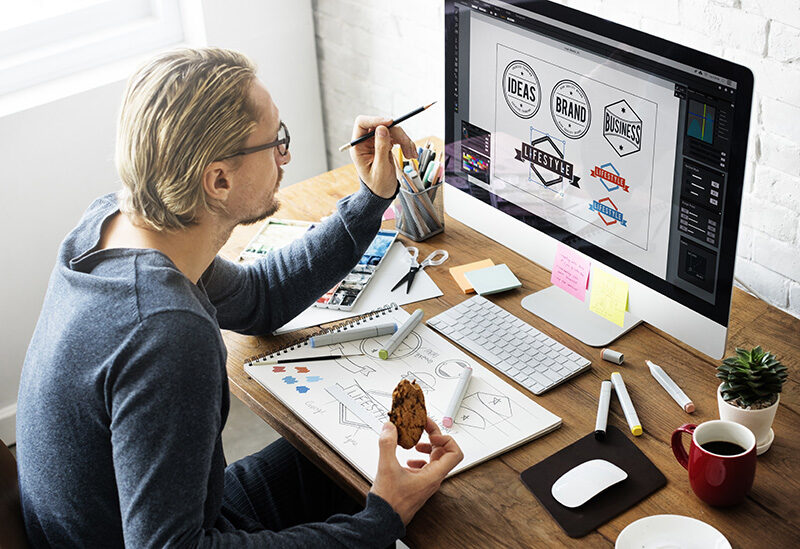Just look at things around you. See that little swoosh on your T-shirt, or do you prefer three stripes or a panther? Then look at your phone, laptop, bag, or even a pen. They all have trademarks on them. And every time you see one, you think about a concrete company and its product. That’s the magic of the logo!
What Is a Logo?
A logo is a graphic representation of a brand. It is created for better recognition of the product and the company that produces it.
Initially, logos were created to distinguish products from the same industry as cars or drinks. Today, any self-respecting brand has a logo and promotes it on a corporate website and social media. Why? Because it works like a subconscious trigger and makes people buy the product just because they see a certain sign on it.
Why Do You Need a Professional Logo?
The logo is the key element of corporate identity that expresses the brand’s uniqueness and exceptionality. It is the main component and central part of the brand’s corporate style.
This little picture gives the first and brightest impression of a company. It is the main tool for linking the visual identity of the company to its brand. It is the logo that determines the color scheme and compositional features of the style of the firm. That’s why the development of a trademark must be approached very responsibly. There’s no place for incompetence.
What Are the Main Functions of a Logo?
Distinctive Function
Looking at a logo, a person doesn’t consciously think that it has any functions. However, a quick read of the information gives your brain an instantly emerging image of the product and its particular manufacturer. It is called an informational or distinctive function of a trademark. It’s one of the most important purposes of the logo: to be recognizable, different from others, and help consumers relate to the product or service offered by a particular company. A person may not even notice, but the brain remembers the logo shown in a TV ad, newspaper, or on a billboard. All these aspects contribute to the recognition of the symbol placed on the product as well as the desire to buy it.
Brand Recognition
This function implies the ability of the logo to remain recognizable even after going through minor changes. It is especially relevant for brands that have been on the market for decades like Coca-Cola and Pepsi. Society is constantly changing, new trends are emerging every year, and sometimes, people just want something new. Adding a small detail or a slight transformation of the logo allows the company to be both modern and recognizable at the same time.
And don’t forget that logo increases business opportunities. A corporate image works like a magnet – it attracts the attention of clients as well as interested investors and potential business partners.
First Impression
It is not enough just to manufacture a high-quality product. You have to find customers who will consistently want to buy your brand. That’s why your product needs to make a positive first impression and become recognized. Therefore, the successful launching of a new brand is impossible without logo development. A well-designed trademark helps the company to form a category of regular customers, which is the foundation of the brand’s financial stability. A new product without a logo may be of great quality, but if it’s not popular, no one will remember it, and it might just remain undervalued. This probability refers to any goods or services, starting from cookies to travel services.
Emotional Part
Brand development is not only about professional drawing or painting. First of all, the emblem will evoke specific emotions from the consumers. Besides, the aesthetic perception of the logo will form the idea of the manufacturer. That is why a designer has to be an expert in the psychology of images, shapes, and colors. For example, blue color signifies calmness and purple means creativity, vertical lines identify dynamics and development, and horizontal lines indicate order and peace.
Influential Function
Studies show that people are willing to pay more for products with the logo. Of course, they don’t pay for print. The presence of a logo on a product gives the client psychological confidence that this good is of high quality and its manufacturer is a serious company. Customers see a trademark as proof of the brand’s successful and steady operation in the market as well as its certainty in the quality of the products and services it provides.
If a customer chooses the product with a logo once and is satisfied with its characteristics, he or she is likely to become a regular client of this brand and use it for decades.
Brand Values
The ideal way to make your logo associable with your company and product is to encrypt some kind of message in it. For example, companies that sell natural products often use images of trees, leaves, and flowers as a part of their trademarks. It helps customers associate their products with nature and natural ingredients. You can go even further and use some abbreviations or signs that can convey the history of the brand or its values. Then create the story of the logo and tell it to your clients. It will help them remember the symbol even faster and build a trustworthy relationship with the brand.
Marketing
Even though professional logos often look simple and even primitive, they play an important part in promoting a company name and its products. An attractive logo is effective marketing and advertising tool that helps businesses popularize their goods and services, create positive brand images, and increase their credibility.
What Is an Effective Logo Design?
For a trademark to perform its functions, it has to meet several requirements:
- Catchiness. The perfect trademark shouldn’t be too complex or overloaded with colors and shades. This makes it comprehensible and easier to remember.
- Uniqueness. Copying the graphic symbols of popular brands is a bad idea because you will only do yourself the biggest disservice. A non-unique image will be perceived as a lack of creativity, charisma, or purpose for the brand. Keep in mind that too many goods and services are offered on the Internet; so, you have to come up with an individual, bright, and memorable logo that will stand out.
- Versatility. Don’t use bitmap graphics. The logo designed with the vector graphics will look good on everything – a web page, business card, or billboard.
- The ability to change colors. A trademark should look as good in black and white colors as in its original one. So, if you ever decide to have an ad in a newspaper, your logo can meet the challenge.
- Relevancy. The symbol should be relevant in the next 10 to 20 years. Don’t try to keep up with fashion trends in design – they change every few years. Using common clichés would also be a mistake. Try to come up with something that is both modern and comes from your heart because honesty is timeless.
How to Get the Perfect Logo?
There are some strict requirements for creating an impeccable brand logo. It has to fully comply with the brand concept, be original and unique, easy to percept and recognize, simple and concise, and versatile and timeless.
When ordering a corporate logo, it is especially important to explain to the designer the idea of the brand and its positioning. The developer must have a good understanding of what the brand is, what are its benefits, and what its target audience is interested in. If you have difficulty formulating the concept and describing the target audience, it’s better to consult with professionals.
Instead of Conclusion
Logo design is a complex creative process. The key element for its development should not be your tastes and color preferences but company values, target audience, and competitor analysis. And don’t forget that there are no good or bad logo designs. There is an effective and ineffective design. If you want your brand to attract customers’ attention, make sure your trademark meets the abovementioned conditions and keep on promoting it.








